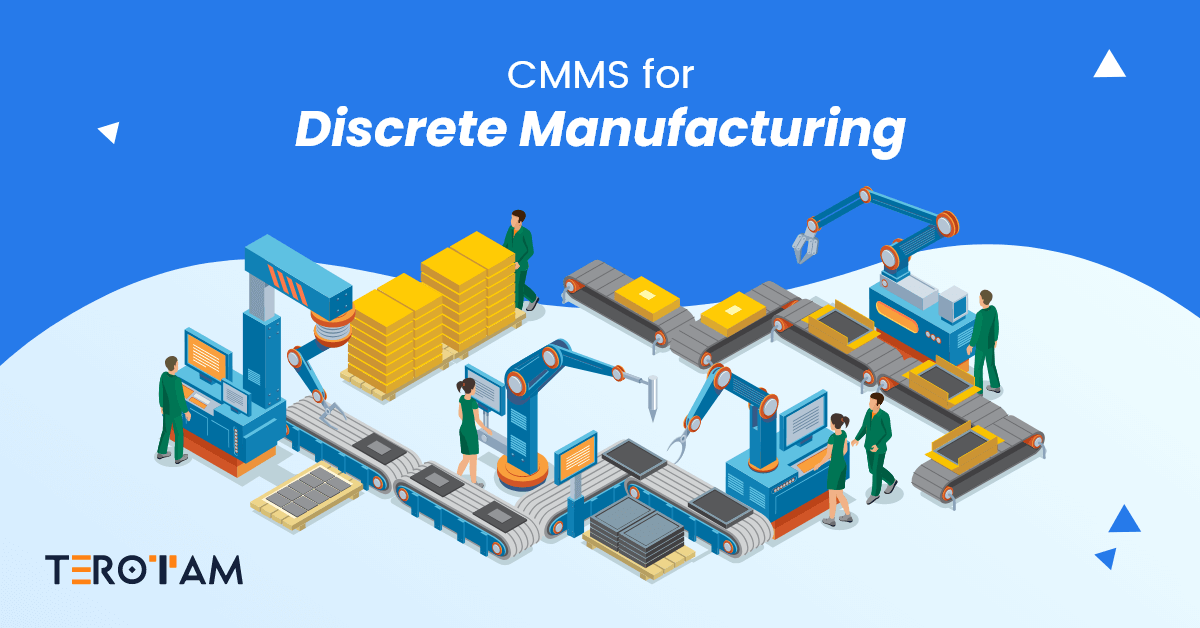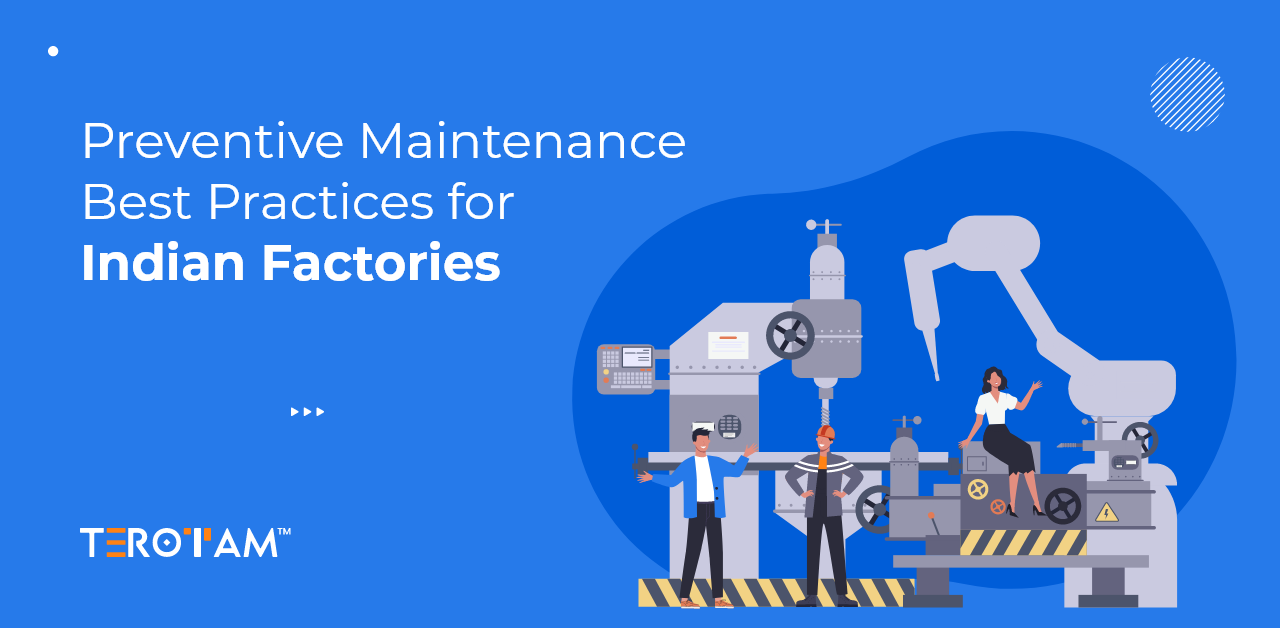In the heart of every humming factory floor lies the crucial task of maintenance management, where the gears of production never stop turning. Managing such an important function in a traditional manual manner will not help achieve the expected efficiency. What is needed now is a systematic maintenance management approach with a proper system that helps to streamline every maintenance planning and implementation with easy-to-manage tracking and evaluation.
With the growing use of technology, Computerized Maintenance Management System (CMMS) software emerges as a transformative tool, revolutionizing the way maintenance tasks are planned, executed, and monitored.
In this article, we are focusing on the significance of CMMS software for discrete manufacturing maintenance management.
Let’s get started with understanding what Discrete manufacturing is.
What is Discrete Manufacturing?
Discrete manufacturing involves the production of distinct items such as automobiles, electronics, appliances, and machinery. Unlike process manufacturing, which deals with continuous production of goods, discrete manufacturing focuses on assembly and fabrication processes where components are assembled or processed into finished products.
The nature of discrete manufacturing demands precise maintenance strategies to ensure optimal equipment performance and minimize downtime.
Major Maintenance Challenges in Discrete Manufacturing
Discrete manufacturing environments are rife with challenges that impede operational efficiency and profitability. Some of the major maintenance challenges include:
Downtime Reduction:
Unplanned downtime disrupts production schedules and incurs significant losses.
Asset Management:
Managing various assets with varying maintenance requirements can be complex and resource-intensive.
Inventory Management:
Maintaining an optimal inventory of spare parts and consumables is crucial to minimize equipment downtime.
Regulatory Compliance:
Adhering to stringent regulatory standards requires meticulous documentation and adherence to maintenance protocols.
Data Management:
Handling vast amounts of maintenance data and deriving actionable insights pose significant challenges in traditional maintenance practices.
Need for Digital Transformation in Discrete Manufacturing Maintenance Management
The need for digital transformation in maintenance management cannot be overstated. Manual record-keeping and reactive approaches are inherently limited in addressing the complexities and challenges of modern manufacturing environments.
Here’s why adopting digital transformation, particularly through CMMS software, is a must in discrete manufacturing:
Complexity of Equipment:
Discrete manufacturing facilities often house a diverse array of equipment, each with its own maintenance requirements and intricacies. Manually managing this complexity is not only labor-intensive but also prone to errors and oversights.
CMMS software streamlines asset management by providing a centralized platform for tracking equipment health, maintenance history, and service schedules.
Increasing Demand for Efficiency:
With growing competition, manufacturers are under constant pressure to optimize production processes and minimize downtime. Reactive maintenance practices, which rely on addressing issues only after they occur, are inherently inefficient and disruptive to operations.
CMMS software facilitates the transition from reactive to proactive maintenance by enabling preventive maintenance scheduling based on equipment condition, usage patterns, and predictive analytics.
Compliance and Regulatory Standards:
Discrete manufacturing firms operate in highly regulated environments, subject to various industry standards and regulatory requirements. Ensuring compliance with these standards necessitates meticulous documentation, adherence to maintenance protocols, and regular inspections.
CMMS software automates compliance management by centralizing maintenance documentation, facilitating audit trails, and sending reminders for scheduled inspections and certifications. Comprehensive reports and record keeping help manufacturers demonstrate compliance with regulatory standards and mitigate associated risks.
Data-Driven Decision-Making:
Manufacturers have access to and need to deal with vast amounts of data, generated by equipment sensors, production systems, and maintenance activities. However, extracting actionable insights from this data can be challenging without the right tools and methodologies in place.
CMMS software leverages advanced analytics capabilities to analyze maintenance data, identify trends, and predict equipment failures before they occur. This allows manufacturers to optimize maintenance strategies, allocate resources more effectively, and make informed decisions to drive continuous improvement and innovation.
Shift Towards Preventive Maintenance:
As manufacturers strive to minimize downtime and maximize asset performance, there is a growing emphasis on adopting preventive maintenance strategies.
With the right CMMS software manufacturer can plan and implement preventive maintenance to avoid the potential issues with timely maintenance. CMMS empowers manufacturers to avoid costly breakdowns, optimize maintenance schedules, and extend the lifespan of critical assets with right preventive maintenance in place.
How does CMMS Help in discrete manufacturing maintenance management?
CMMS software offers multiple features and functionalities tailored to address the unique maintenance requirements of discrete manufacturing firms. Let’s take a look at it quickly.
Asset Tracking and Management:
- Creating Asset register and carrying out Physical as well as Digital asset verification.
- Utilizes RFID tags and QR Code scanning for real-time tracking.
- Implements IoT sensors to monitor equipment health and performance.
- Manage asset depreciation to disposition process on centralized platform
- With Asset’s geo-tagging, it manages restricted access to asset and related information.
- Utilizes CMMS dashboards for visualization and analysis of maintenance data.
Preventive Maintenance Scheduling:
- Implements condition-based monitoring through IoT sensors and data analytics.
- Schedule up to 52 weeks preventive maintenance calendar to avoid unwanted breakdown.
- Data gathered on preventive maintenance as well as on breakdown maintenance helps you decide asset repair or replace decisions.
- Calculation of MTBF (Mean Time Between Failures) and MTTF (Mean Time To Failure) helps in optimizing maintenance schedules and predicting equipment reliability.
- FMEA is used to assess potential failure modes and prioritize preventive maintenance tasks accordingly.
Operations Management:
- Streamlines day-to-day operations management tasks through CMMS.
- Utilizes checklists and standardized procedures for routine maintenance activities.
- Integrates with production systems to coordinate maintenance schedules with production schedules.
- Provides real-time visibility into equipment status and maintenance activities for operational decision-making.
Issue and Ticket Management:
- Simply create a complaint ticket with simple QR code scanning with easy to use mobile access.
- Assign it to the relevant internal staff or outside vendor.
- Tracks maintenance issues and service requests through a centralized ticketing system within the CMMS.
- Assigns priority levels and TAT to tickets based on the severity and impact of the issue.
- Enables efficient communication and collaboration between maintenance teams and stakeholders.
- Escalate it to the next level if not completed within the TAT time.
Work Order Management:
- Streamlines work order generation, assignment, and tracking processes.
- Ensures timely resolution of maintenance issues and efficient resource allocation.
- Improves overall workflow efficiency and productivity.
Inventory Management:
- Manages spare parts inventory and tracks usage.
- Optimizes inventory levels and streamlines procurement processes.
- Ensures availability of necessary parts for timely maintenance tasks.
Permit to Work Management:
- Manages Hot and Cold Work permits with Gate pass and work permit pass issuance.
- Utilizes CMMS to track permit status, approvals, and expiry dates.
- Integrates with safety management systems to ensure compliance with regulatory requirements.
- Facilitates collaboration between maintenance teams and other departments for permit issuance and approval processes.
Analytics and Reporting:
- Provides advanced analytics tools for analyzing key performance indicators.
- Identifies trends and patterns to optimize maintenance strategies.
- Enables data-driven decision-making for continuous improvement.
Conclusion
CMMS software stands as a powerful tool in revolutionizing maintenance management within discrete manufacturing. With its ability to streamline operations, enhance asset performance, and ensure regulatory compliance, CMMS software empowers organizations who are envisioned toward growth.
For more insights on how CMMS can optimize management & maintenance processes in a Discrete manufacturing unit, connect with us now or write to us at contact@terotam.com







